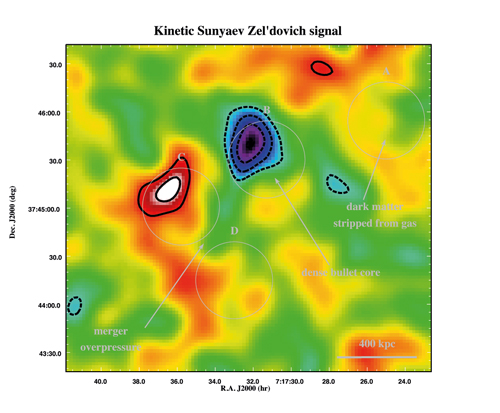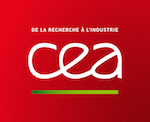 A team of researchers from the NIKA consortium, led by Rémi Adam (Laboratoire Lagrange – OCA, UCA, LPSC Grenoble, CNES), Iacopo Bartalucci and Gabriel Pratt (CEA Saclay), has obtained for the first time an image of the gas velocity in a merging cluster of galaxies
A team of researchers from the NIKA consortium, led by Rémi Adam (Laboratoire Lagrange – OCA, UCA, LPSC Grenoble, CNES), Iacopo Bartalucci and Gabriel Pratt (CEA Saclay), has obtained for the first time an image of the gas velocity in a merging cluster of galaxies
These observations open a new way to study the formation of the largest structures in the Universe, formed through the most energetic events since the Big Bang. Prior these observations, the NIKA consortium, led by Alain Benoit and Alessandro Monfardini (Institut Néel), has also designed, tested and commissioned the instrument.
 |
| Figure 1 - Multi-wavelength image of MACS J0717.5+3745 showing the galaxy distribution (green, Hubble Space Telescope data from Postman et al. 2012, ApJS, 199, 25), the gas electron density (red, Chandra X-ray data, ObsID4200), the gas electron pressure (blue, NIKA) and the kSZ signal (yellow contours, NIKA, Figure 2). The gray circles indicate the main subclusters. |
 |
 |
| Figure 2 - Left: kSZ signal toward MACS J0717.5+3745 (signal-to-noise ratio), which provides the gas line of sight momentum. Right: gas line of sight velocity map, in km/s, with respect to the CMB reference frame. | |
The Universe in which we live today has been shaped by the gravitational collapse of large-scale structures that started to form about 14 billion years ago, right after the Big Bang. Today, the largest gravitationally bound objects, which constitute the building blocks of our Universe, are the clusters of galaxies. Despite their name, galaxy clusters are mainly composed of dark matter (~85%) and hot ionized gas (~12%), with only a few percent of the mass contained in galaxies. Cluster formation is driven by the gravitational collapse of the dark matter, the gas and galaxies “following” this process. During their assembly, clusters can collide at high velocity. These mergers are the most energetic events since the Big Bang and they are fundamental to understand the assembly of structures in the Universe.
One way to study the velocity of clusters is to measure the imprint of their motion in the Cosmic Microwave Background (CMB) radiation through use of the kinetic Sunyaev-Zel’dovich (kSZ) effect. This effect arises from the Doppler shift of CMB photons when they interact with fast-moving electrons in the intra-cluster gas. The kSZ effect is the only known way to directly measure the peculiar velocity of objects at cosmological distances, because unlike other methods, the CMB radiation provides an absolute reference for the measurement. While its thermal homologue (the thermal Sunyaev-Zel’dovich effect, tSZ) is now routinely used to measure the gas pressure in clusters, the kSZ effect remains very challenging to observe and only a handful of low significance detections have been obtained so far.
The New IRAM KIDs Array (NIKA) was the prototype of the larger camera, NIKA2, recently installed at the IRAM 30m telescope. NIKA and NIKA2 observe astronomical signals at 150 and 260 GHz, and in principle, this dual-band approach allows astronomers to extract both the tSZ and the kSZ signal when looking at clusters. Motivated by the challenge and the high performances of NIKA, the team decided to attempt a kSZ measurement by mapping one of the most violent cluster mergers, MACS J0717.5+3745, at a redshift of 0.55 (Figure 1).
Such kSZ mapping provides the gas momentum integrated along the line-of-sight relative to the CMB reference frame; it is therefore a goldmine of information to understand the physics of merging clusters. The data revealed that the two main subclusters in MACS J0717.5+3745, namely B and C (Figure 1), are falling onto one another with extremely large momentum (Figure 2, left). “Simply detecting the kSZ effect is already an excellent result in itself, but when we realized that we were able to obtain a map of the signal, this was a tremendous achievement for us” says Rémi Adam.
Measuring the kSZ signal is a first step, but it is even more challenging to measure the velocity of the gas itself because one needs to disentangle the kSZ signal from the gas density distribution along the line-of-sight. This procedure required the use of X-ray observations from the XMM-Newton and Chandra satellites, which, together with a comprehensive model of the cluster, allowed the team to constrain the velocity and even to extract a map of the projected gas velocity with respect to the CMB rest frame (Figure 2, right). The resulting image is not obvious to interpret as it depends on the modeling assumptions. Nevertheless, it is striking as it shows, for the first time, an image of the moving gas in a distant cluster of galaxies
These results open up a new way to study merging clusters, showing that such observations are now possible with high angular resolution and high sensitivity instruments, such as the NIKA camera at the IRAM 30m telescope. With the new instrument NIKA2 now being commissioned, the prospects for studying galaxy clusters, including mergers through the kSZ effect, are very bright. This will allow astronomers to further investigate the formation of large-scale structures in the distant Universe.
Références:
- Contact project lead: Rémi Adam - remi.adam@oca.eu
- R. Adam, I. Bartalucci, G.W. Pratt et al., “Mapping the kinetic Sunyaev-Zel’dovich effect in MACS J0717.5+3745”, accepted for publication in the « Astronomy and Astrophysics » journal. The article is already available online at: http://arxiv.org/abs/1606.07721
- The NIKA2 consortium website can be consulted for more information about the instrument: http://ipag.osug.fr/nika2/Welcome.html
- The IRAM website dedicated to NIKA and NIKA2 can be found at: http://www.iram.es/IRAMES/mainWiki/NIKA/Main
- The NIKA consortium involves scientists, engineers and technicians from Institut Néel, IPAG, LPSC, IRAM, IAS, CEA, IRAP, IEF, IAP, Paris Observatory, Sapienza Università di Roma, LAM, UCL, Cardiff University, ESO, Lagrange laboratory (OCA), and IAC. The present results also involve scientists from JPL, RIT, Arizona State University, the University of Arizona, and Università degli Studi di Roma « Tor Vergata ».
- The NIKA consortium acknowledges support from ANR NIKA, ANR NIKA2Sky, ERC ORISTARS, FOCUS, ENIGMASS, INP, INSIS, INSU, IN2P3, and UGA.











